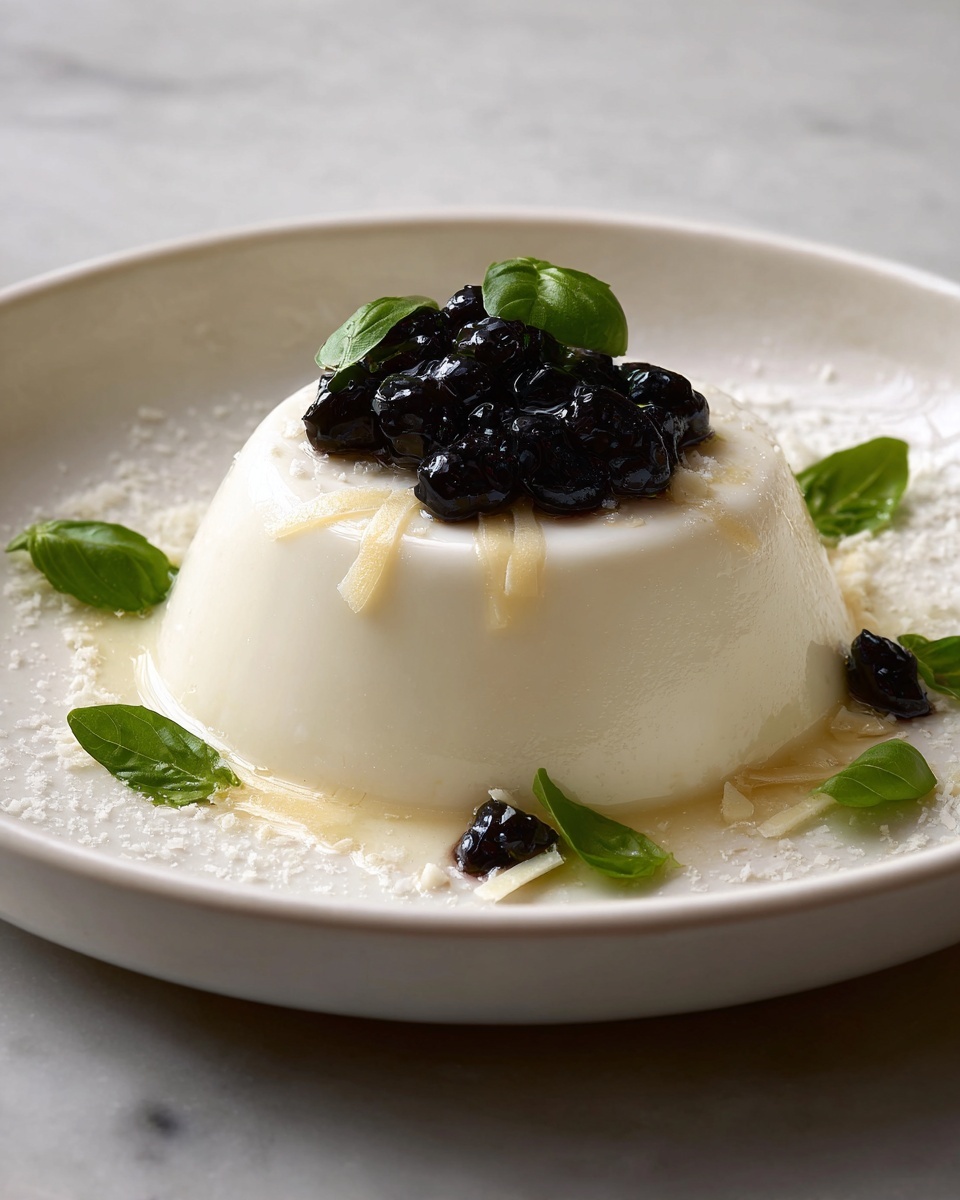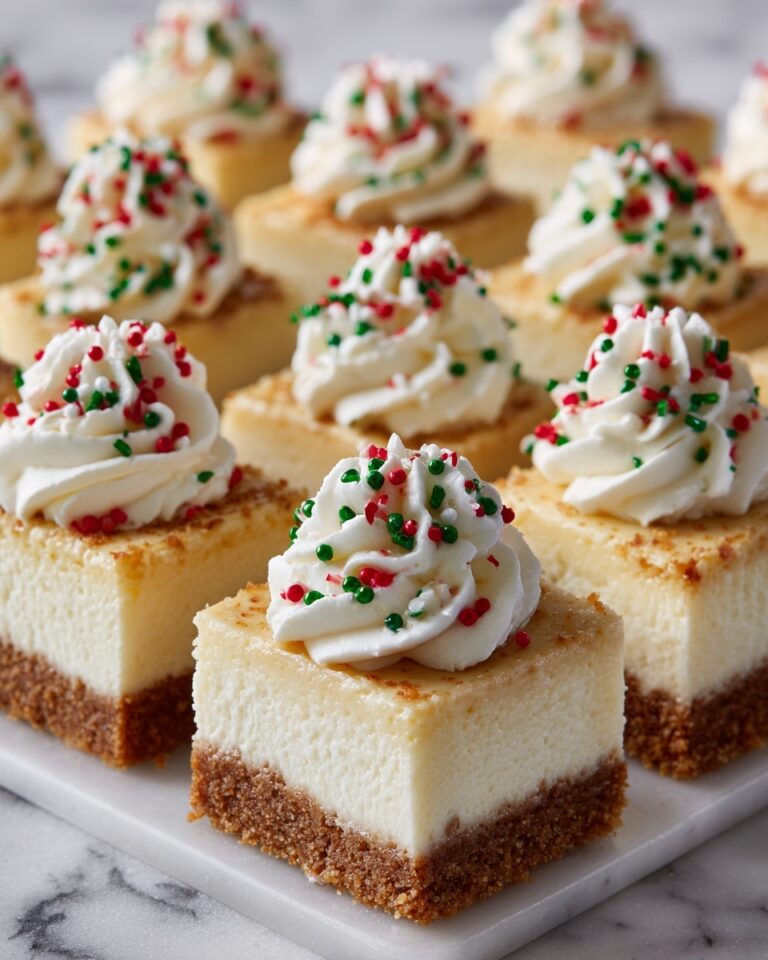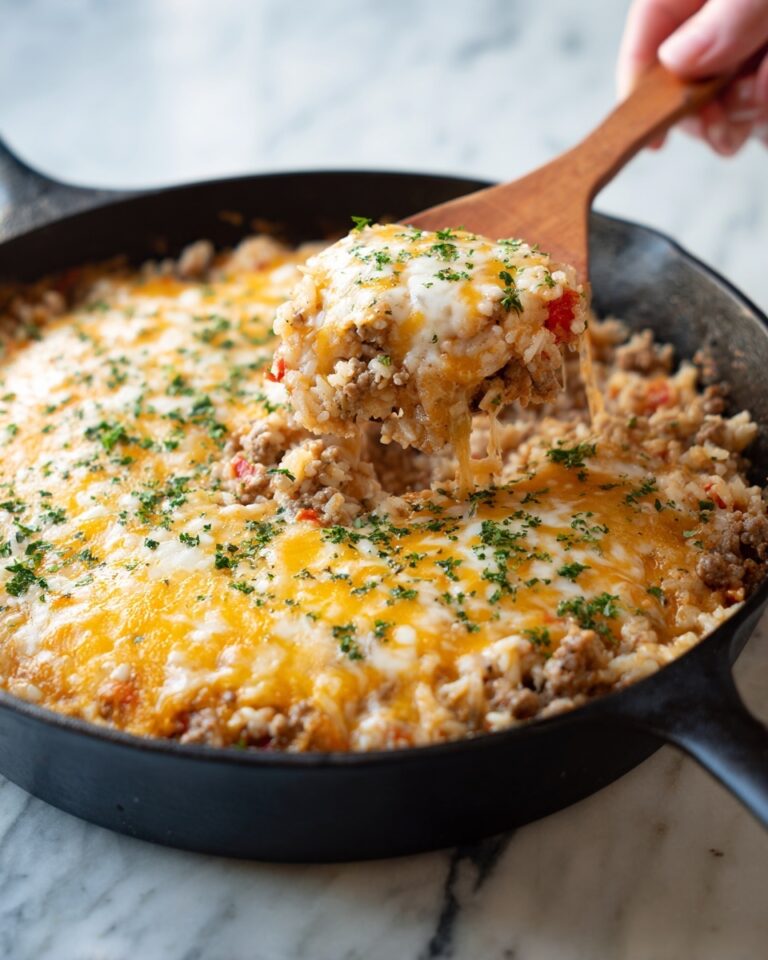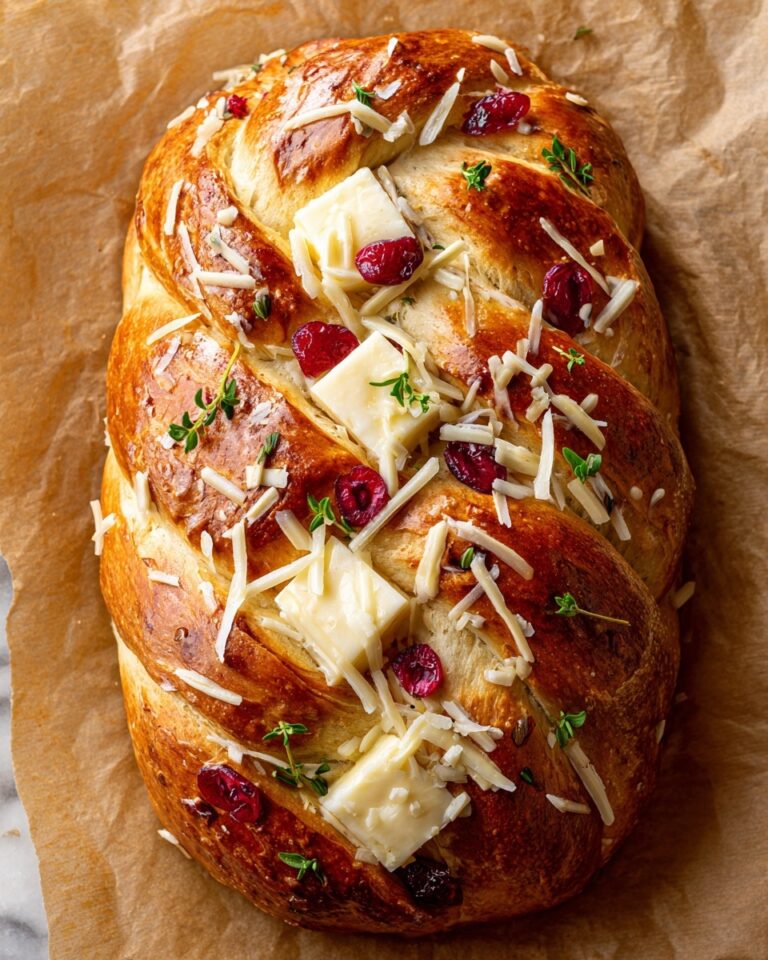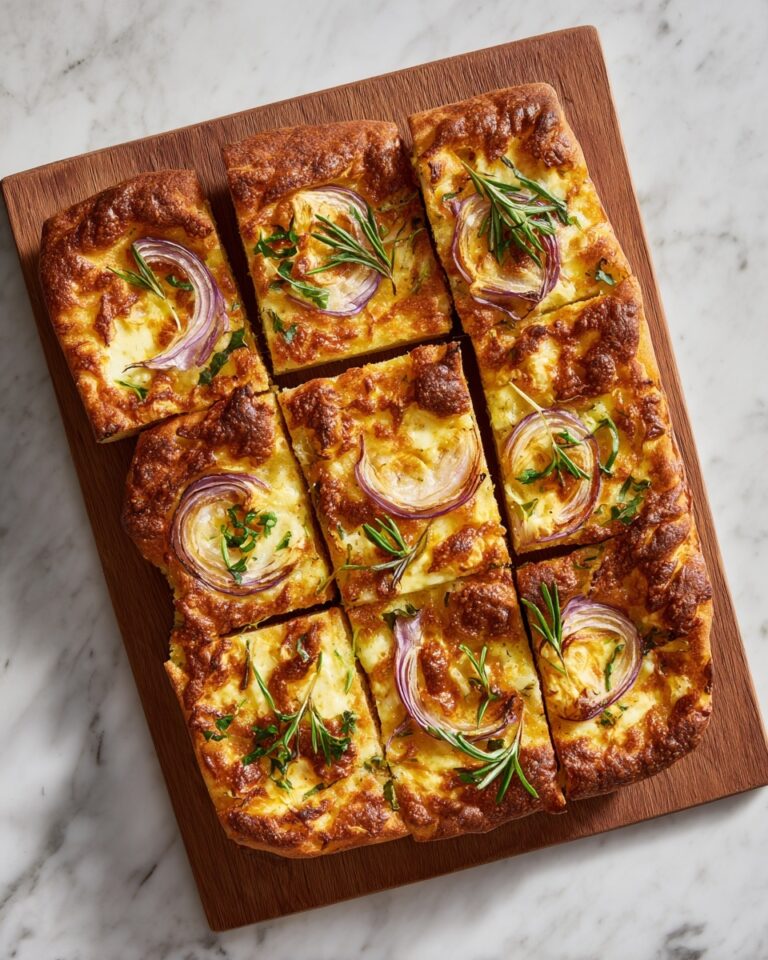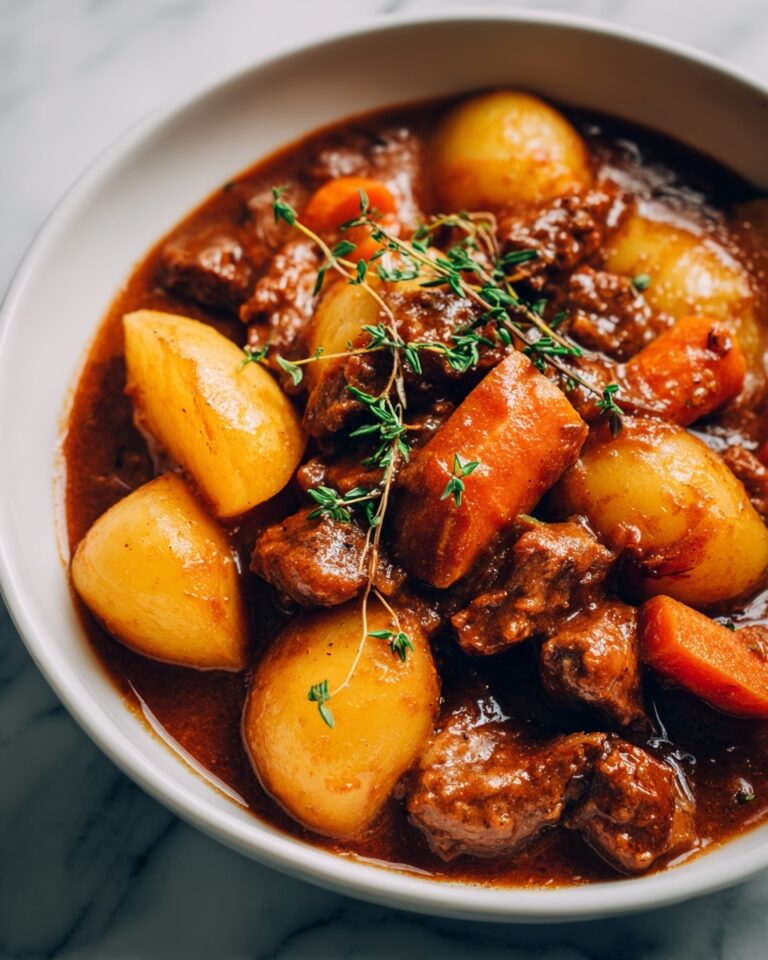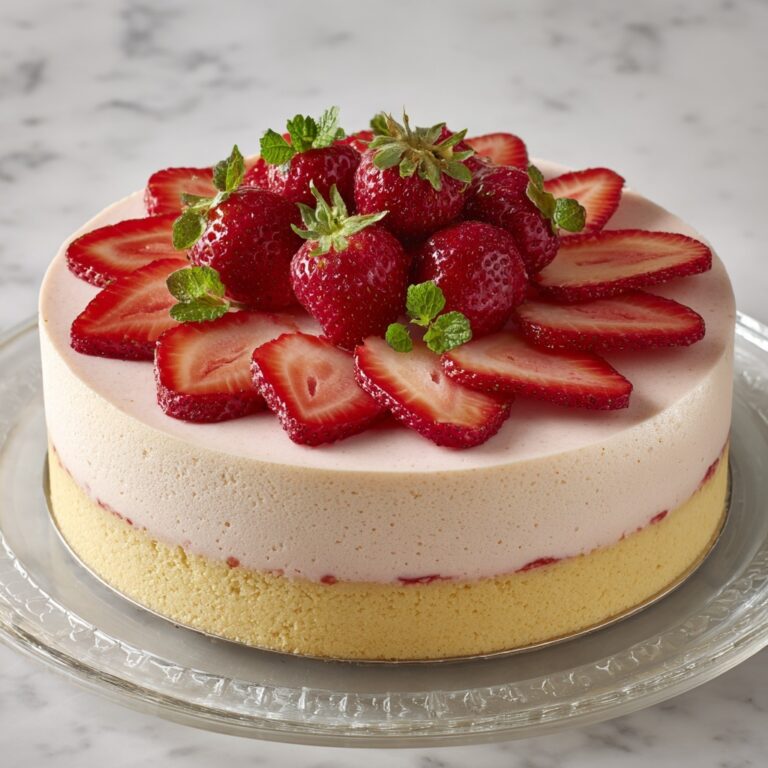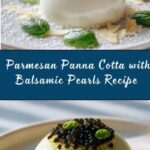Deliciously creamy and unexpectedly elegant, this Parmesan Panna Cotta with Balsamic Caviar Pearls Recipe offers a stunning twist on a classic Italian favorite. The silky, savory panna cotta beautifully balances the sharp, nutty flavors of Parmigiano-Reggiano, while the glossy balsamic pearls burst with tangy sweetness, creating an unforgettable taste sensation. It’s a dish that effortlessly impresses guests or elevates a cozy dinner for two, combining artistry with flavor in every bite.
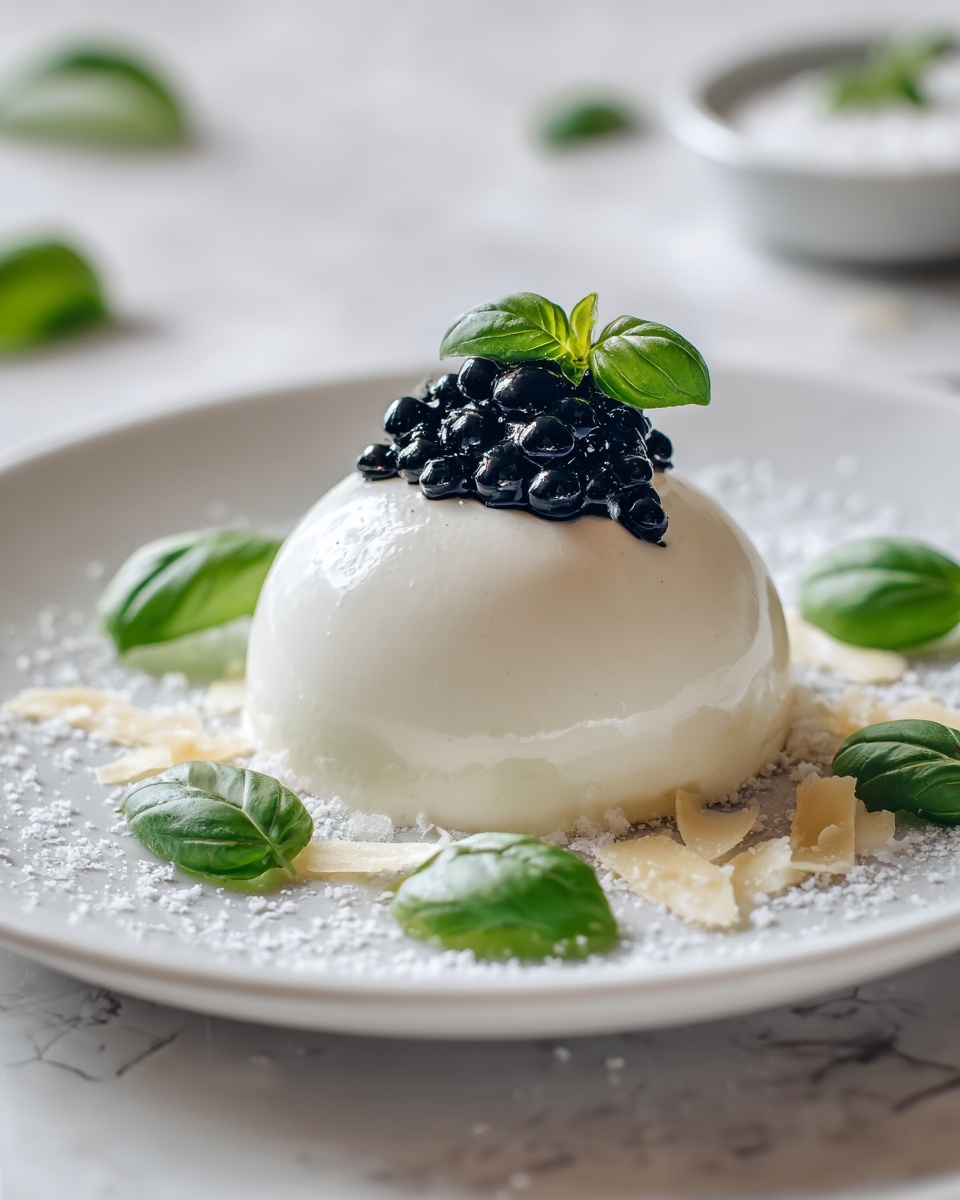
Ingredients You’ll Need
Each ingredient in this Parmesan Panna Cotta with Balsamic Caviar Pearls Recipe serves a crucial role, combining simplicity with sophistication. From the rich cream that gives the panna cotta its luxurious texture to the precise components of the balsamic caviar, you’ll find each element enhances the overall dish beautifully.
- Heavy cream (250 ml): The key to achieving the panna cotta’s rich, creamy texture that melts in your mouth.
- Whole milk (125 ml): Adds a lighter consistency and balances the richness of the cream.
- Finely grated Parmigiano-Reggiano (100 g): Provides that signature nutty, savory flavor essential to the dish’s character.
- Gelatin leaves (1½) or powdered gelatin (1 tsp): Ensures the panna cotta sets perfectly without overpowering taste.
- White pepper (pinch): Offers subtle warmth without dark specks, preserving the panna cotta’s pristine appearance.
- Nutmeg (pinch, optional): Adds a gentle aromatic note that complements the cheese beautifully.
- High-quality balsamic vinegar (100 ml): The heart of the balsamic caviar, providing sweet and tangy bursts.
- Sodium alginate (1.5 g): A crucial ingredient to create those shimmering balsamic pearls through spherification.
- Water for calcium bath (250 ml): Used along with calcium chloride to form the pearl’s delicate gel coating.
- Calcium chloride (2 g): Reacts with sodium alginate to create those perfect balsamic pearls.
- Ice water bath: Keeps the balsamic pearls fresh and firm before serving.
- Microgreens or baby basil leaves: Provide a fresh, herbal garnish for a pop of color and flavor.
- Extra shaved parmesan (optional): Adds visual appeal and intensified cheesy flavor as a finishing touch.
- Freshly cracked black pepper: For a bit of bold spice to contrast the creamy and sweet elements.
How to Make Parmesan Panna Cotta with Balsamic Caviar Pearls Recipe
Step 1: Prepare the Gelatin
Begin by soaking the gelatin leaves in cold water for about 5 minutes to soften them fully. If you’re using powdered gelatin instead, sprinkle it over a tablespoon of milk to bloom. This step ensures your panna cotta will have the perfect delicate set without any lumps or graininess.
Step 2: Infuse Cream and Milk with Parmesan
Gently warm the heavy cream and whole milk in a saucepan over low heat. Slowly stir in the finely grated Parmigiano-Reggiano until it melts completely. As the cheese infuses into the warm liquid, add a pinch of white pepper for subtle heat and a dash of nutmeg if you’d like to give the dish an extra aromatic touch. Be patient here—low and slow heating brings out the best texture and flavor.
Step 3: Combine Gelatin and Cheese Mixture
Remove the saucepan from heat and immediately stir in your softened gelatin until fully dissolved. This step is crucial for that smooth, velvety panna cotta texture. Strain the mixture through a fine sieve to catch any un-melted bits, ensuring your final panna cotta remains silky and flawless.
Step 4: Chill the Panna Cotta
Pour the liquid into individual molds or ramekins and refrigerate for at least 4 hours, allowing the panna cotta to set completely. This slow chilling step lets the flavors meld together while creating a luxurious, firm yet tender texture.
Step 5: Prepare the Calcium Chloride Bath
While your panna cotta chills, mix the calcium chloride with 250 ml of water in a shallow bowl. This calcium bath is essential for the spherification process, which transforms balsamic vinegar into delightful caviar pearls.
Step 6: Blend Balsamic Vinegar with Sodium Alginate
Blend together the balsamic vinegar and sodium alginate until the mixture is smooth and lump-free. Then, let it rest for 10–15 minutes to allow any trapped air bubbles to escape. This step is vital for creating perfectly spherical, shiny balsamic pearls.
Step 7: Create the Balsamic Caviar Pearls
Using a pipette, carefully drop the balsamic mixture one drop at a time into the calcium bath. As each drop sinks, it will form into a luscious, gel-coated pearl within about 1 minute. These tiny bursts of flavor add dramatic visual interest and a burst of tangy sweetness to the creamy panna cotta.
Step 8: Rinse and Store the Pearls
Transfer the pearls gently into an ice water bath to set fully, then drain carefully and store them until you’re ready to garnish your panna cotta. Keeping them cool maintains their texture and flavor integrity.
Step 9: Serve Your Masterpiece
Unmold the panna cotta onto chilled plates, top generously with the glistening balsamic pearls, and finish with fresh microgreens or baby basil leaves. For an extra flavor punch, add some shaved parmesan and a sprinkle of freshly cracked black pepper. Serve chilled and prepare for compliments galore!
How to Serve Parmesan Panna Cotta with Balsamic Caviar Pearls Recipe
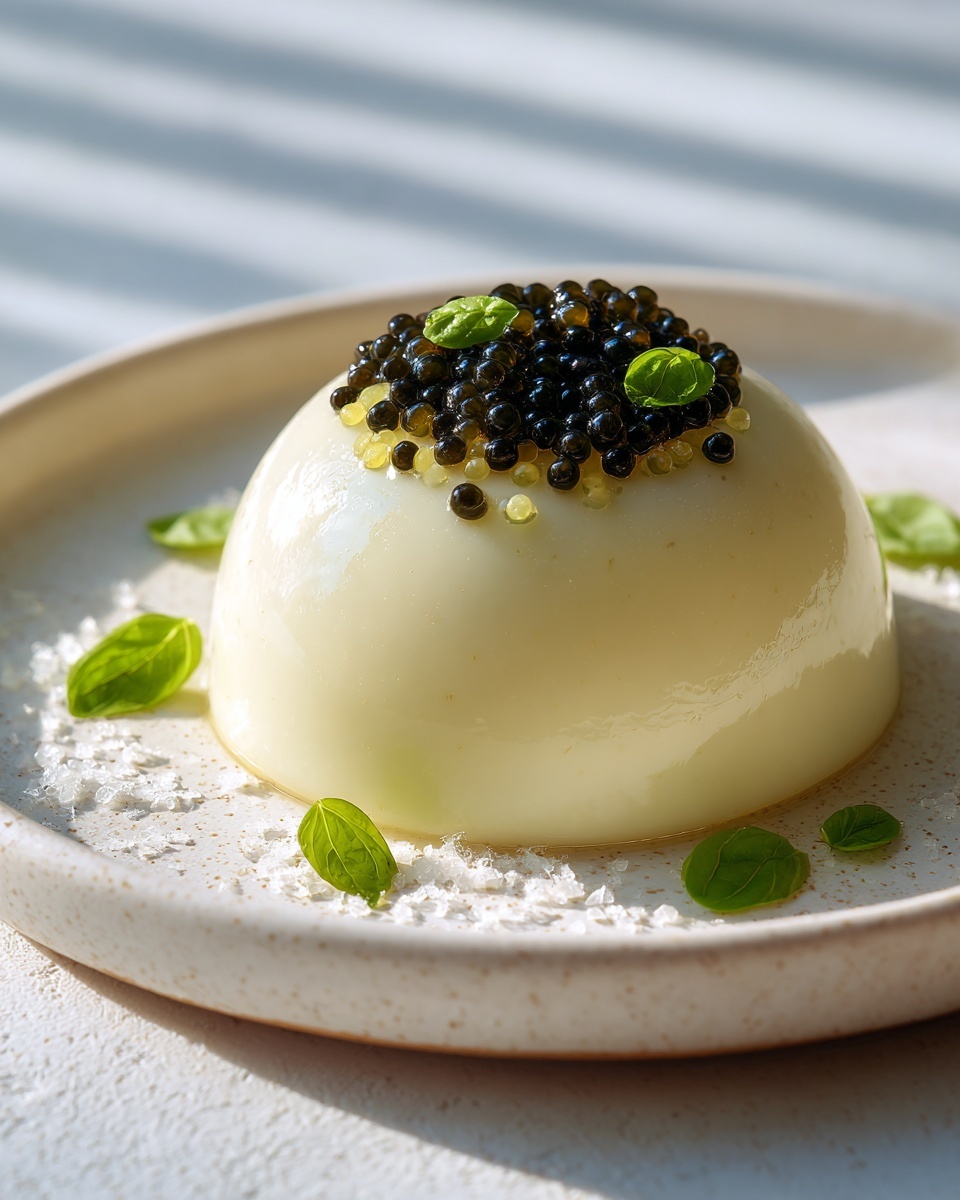
Garnishes
Microgreens or baby basil leaves add a vibrant, fresh contrast to the creamy panna cotta. A few shavings of extra Parmesan not only enhance the dish’s savory depth but also provide beautiful textural contrast. Don’t forget a final crack of black pepper—it wakes up all the flavors splendidly.
Side Dishes
This Parmesan Panna Cotta with Balsamic Caviar Pearls Recipe shines as an elegant starter or a sophisticated standalone dish, but if you want to round out your meal, consider pairing it with a crisp arugula salad dressed with lemon vinaigrette or a crusty artisan bread to soak up the delicate balsamic juices.
Creative Ways to Present
Try serving the panna cotta in clear glass cups to showcase the creamy layers and glossy balsamic pearls. Another fun way is to present the pearls separately in a small spoon alongside the panna cotta, encouraging guests to mix flavors with each bite. The visual play of textures is as delightful as the taste.
Make Ahead and Storage
Storing Leftovers
If you have any panna cotta left, keep it refrigerated in airtight containers or covered molds. It will stay fresh for up to 2 days but is best enjoyed within 24 hours to savor the delicate textures and flavors at their peak.
Freezing
Because of its creamy and delicate nature, freezing the panna cotta is not recommended—it will lose its smooth texture upon thawing. The balsamic pearls also do not freeze well, as their gel coating can break down.
Reheating
This dish is designed to be served chilled, so reheating is not necessary or advised. Instead, remove the panna cotta from the fridge shortly before serving to let it sit at a slightly warmer temperature for optimal creaminess and flavor delivery.
FAQs
Can I use powdered gelatin instead of gelatin leaves?
Absolutely! Just bloom the powdered gelatin in a small amount of milk before adding it to the warm cream mixture. The texture and setting will be just as perfect.
What is balsamic caviar, and how does it work?
Balsamic caviar is created using a modern culinary technique called spherification. Sodium alginate mixes with balsamic vinegar, and when dropped into a calcium chloride solution, it forms tiny jelly-like pearls that burst with flavor when eaten.
Can I make this recipe vegan or vegetarian-friendly?
This recipe relies on Parmesan cheese and gelatin, which are animal products. For a vegetarian twist, consider using a vegetarian-friendly Parmesan and agar-agar instead of gelatin. Vegan adaptations would require plant-based cheeses and gelling agents that mimic the panna cotta’s texture.
How far in advance can I make the balsamic pearls?
You can prepare the balsamic pearls a few hours ahead and store them in ice water in the refrigerator. Just drain them well before serving to keep their texture intact.
What is the best way to unmold the panna cotta?
To unmold easily, briefly dip the molds into warm water for a few seconds to loosen edges, then gently invert onto serving plates. Running a thin knife around the edges beforehand also helps release the panna cotta smoothly.
Final Thoughts
This Parmesan Panna Cotta with Balsamic Caviar Pearls Recipe is a true showstopper that combines creative elegance with approachable flavors. It’s one of those dishes you’ll remember making—and sharing—because it turns simple ingredients into a spectacular dining experience. Give it a try, and watch how it becomes a new personal favorite on your recipe list!
Print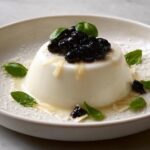
Parmesan Panna Cotta with Balsamic Caviar Pearls Recipe
- Prep Time: 20 minutes
- Cook Time: 10 minutes
- Total Time: 4 hours 30 minutes
- Yield: 4 servings
- Category: Dessert
- Method: No-Cook
- Cuisine: Italian
- Diet: Gluten Free
Description
A sophisticated and creamy Parmesan Panna Cotta paired with delicate balsamic vinegar caviar pearls. This elegant dessert combines savory and tangy flavors with a silky texture, perfect for impressing guests with a gourmet touch.
Ingredients
For the Parmesan Panna Cotta
- 250 ml heavy cream
- 125 ml whole milk
- 100 g finely grated Parmigiano-Reggiano
- 1½ gelatin leaves (or 1 tsp powdered gelatin)
- Pinch of white pepper
- Pinch of nutmeg (optional)
For the Balsamic “Caviar”
- 100 ml high-quality balsamic vinegar
- 1.5 g sodium alginate
- 250 ml water
- 2 g calcium chloride
- Ice water bath (amount as needed)
To Serve
- Microgreens or baby basil leaves
- Extra shaved parmesan (optional)
- Freshly cracked black pepper
Instructions
- Prepare Gelatin: Soak gelatin leaves in cold water for 5 minutes until softened, or if using powdered gelatin, bloom it in a tablespoon of milk and set aside.
- Warm Dairy and Parmesan: In a saucepan over low heat, gently warm the heavy cream and whole milk. Gradually stir in the finely grated Parmigiano-Reggiano until it is completely melted and incorporated. Add a pinch of white pepper and nutmeg if using for extra flavor.
- Dissolve Gelatin: Remove the saucepan from heat. Stir in the soaked or bloomed gelatin thoroughly until fully dissolved, resulting in a smooth mixture without lumps.
- Strain and Chill: Pour the panna cotta mixture through a fine sieve to ensure smoothness. Transfer the mixture into molds and refrigerate for at least 4 hours, or until firmly set.
- Prepare Calcium Bath: Combine 2 g calcium chloride with 250 ml water in a shallow bowl, stirring until fully dissolved. This will serve as the setting bath for the balsamic caviar pearls.
- Mix Balsamic and Sodium Alginate: Blend 100 ml balsamic vinegar with 1.5 g sodium alginate until the mixture is completely smooth. Let the mixture rest for 10 to 15 minutes to remove any air bubbles for best results.
- Create Balsamic Pearls: Using a pipette, carefully drop the balsamic mixture one drop at a time into the calcium chloride bath. Allow the drops to form into caviar-like spheres and set for about 1 minute.
- Rinse Pearls: Remove the balsamic pearls from the calcium bath and rinse them gently in an ice water bath to halt the setting process. Drain the pearls well and keep them ready for serving.
- Serve: Unmold the set Parmesan panna cotta onto serving plates. Top with the balsamic caviar pearls, garnish with microgreens or baby basil leaves, extra shaved parmesan if desired, and finish with freshly cracked black pepper. Serve chilled for an elegant appetizer or dessert.
Notes
- Be sure to use high-quality Parmigiano-Reggiano for the best flavor in the panna cotta.
- Sodium alginate and calcium chloride are specialty ingredients used for molecular gastronomy caviar; they can be found in specialty cooking stores or online.
- Ensure the gelatin is completely dissolved to avoid lumps in the panna cotta.
- The resting time for the balsamic and sodium alginate mixture is important to remove air bubbles, which can affect pearl formation.
- Handle the balsamic pearls gently as they are delicate and can burst easily.
- Refrigerate the panna cotta for at least 4 hours or overnight for best set and flavor development.

